Financial Management Report: Financial Planning and Budgeting
VerifiedAdded on 2020/02/05
|24
|4556
|32
Report
AI Summary
This financial management report provides a detailed overview of key concepts, sources of finance, and financial planning strategies. It begins with an introduction to financial management and its importance for organizational growth, survival, and sustainability. The report then explores different sources of finance for various business types, including new businesses, existing businesses, and large businesses, discussing equity finance, debt finance, and internal sources like retained earnings. The report also examines the advantages and disadvantages of different financing options, such as share capital, retained earnings, bank loans, and government grants. Furthermore, the report includes case studies of small business start-ups, large business expansions, and existing medium-sized companies. The report also discusses financial planning, cash flow management, and the importance of various financial statements, including the balance sheet, cash flow statement, and income statement. Finally, the report analyzes sales budgets, identifies issues, and suggests solutions related to selling and pricing strategies.
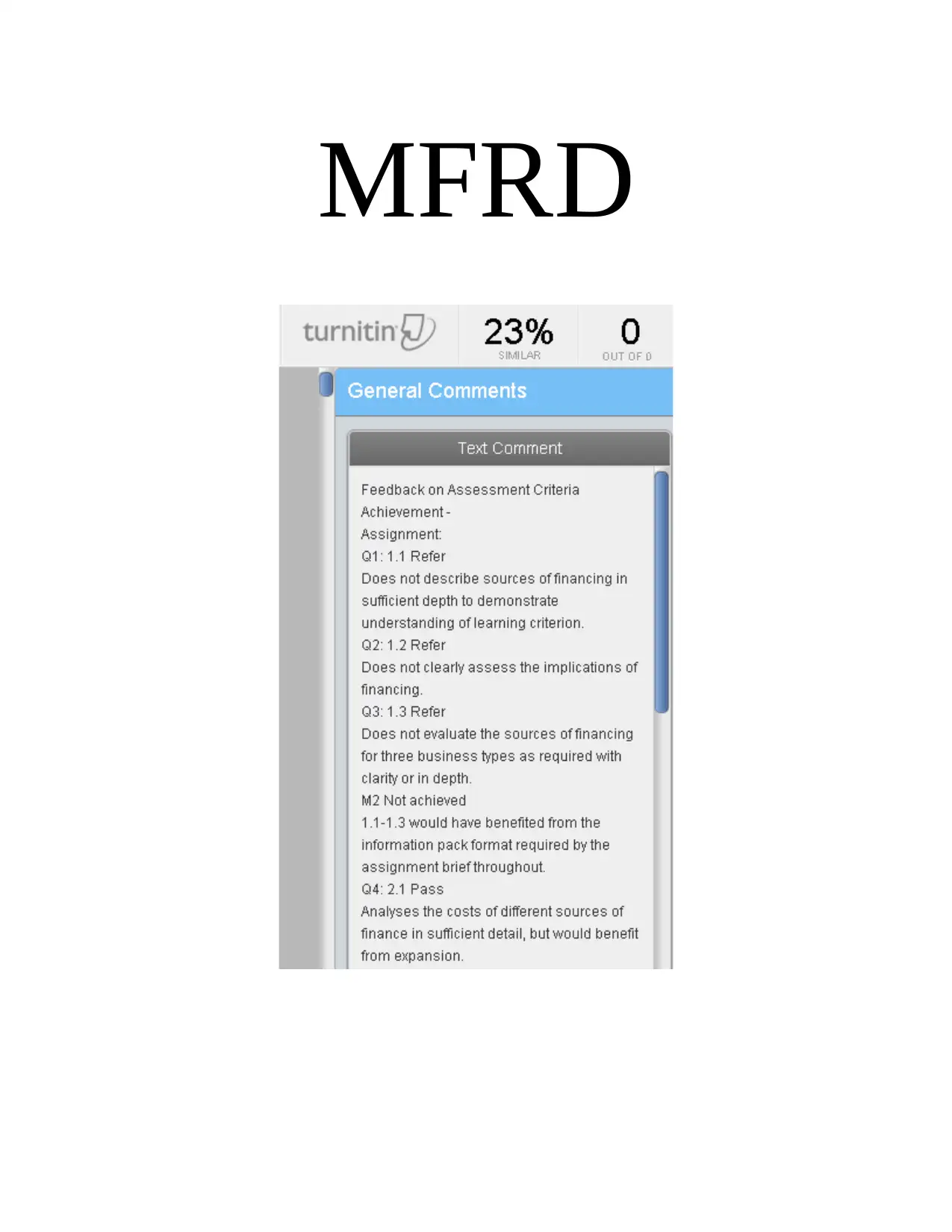
MFRD
Paraphrase This Document
Need a fresh take? Get an instant paraphrase of this document with our AI Paraphraser
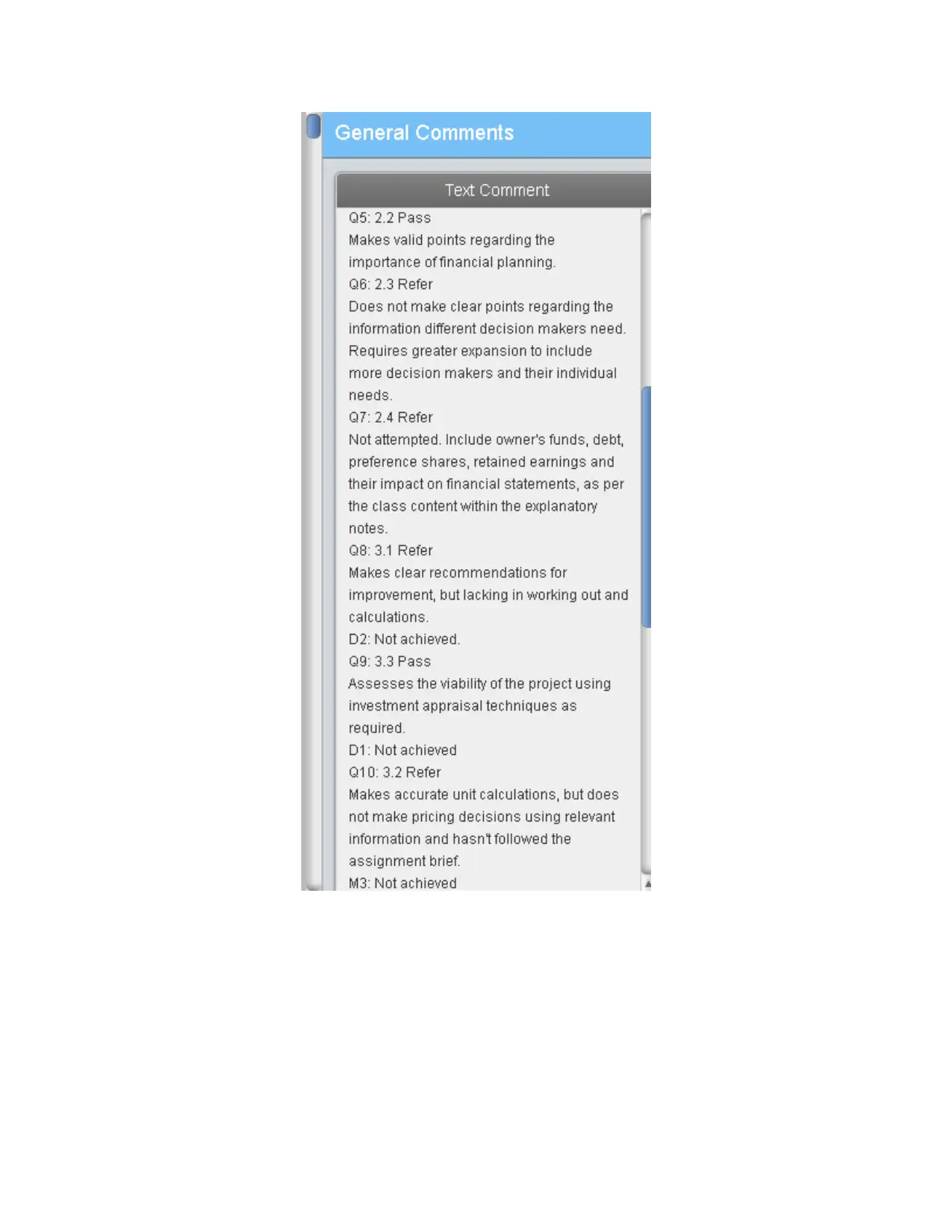
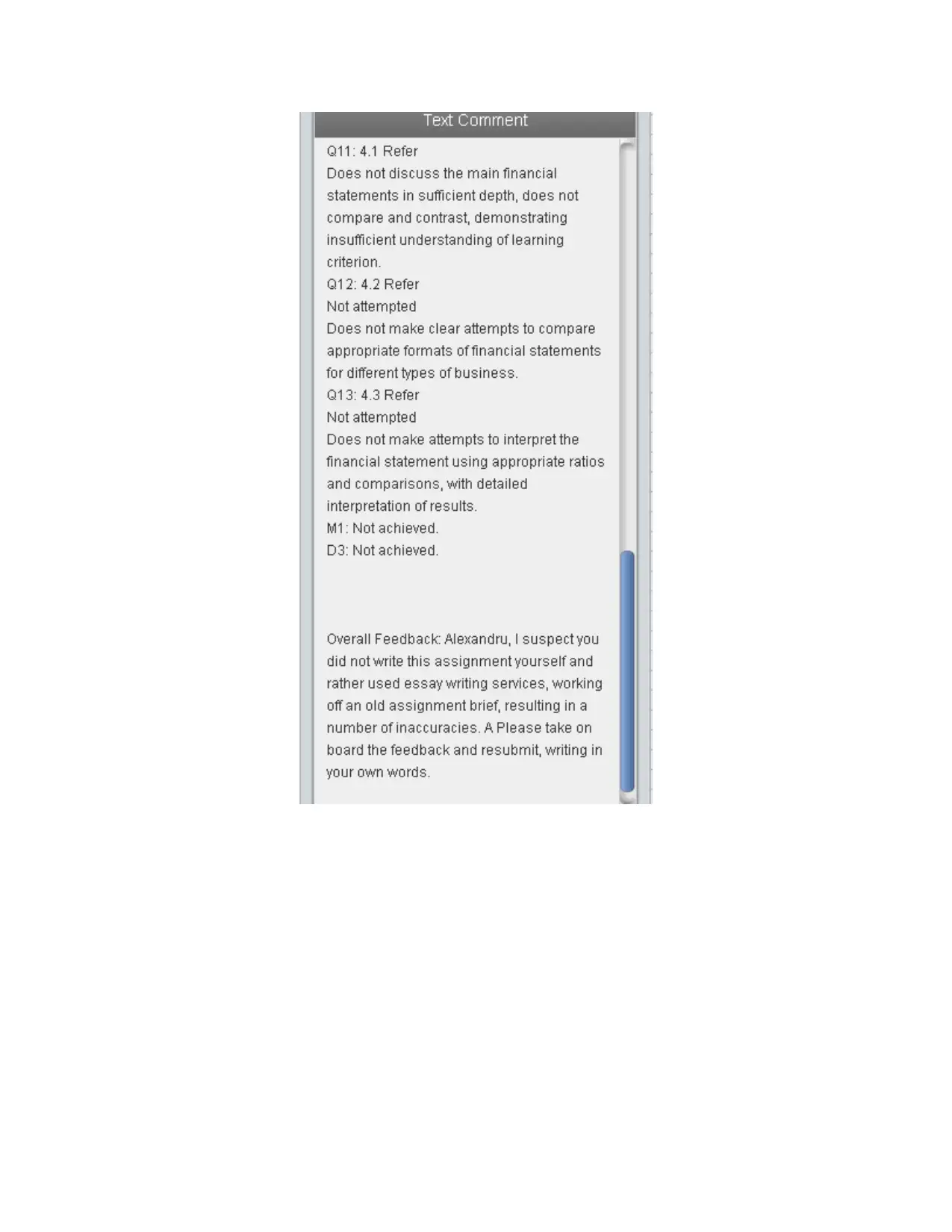
⊘ This is a preview!⊘
Do you want full access?
Subscribe today to unlock all pages.

Trusted by 1+ million students worldwide

Paraphrase This Document
Need a fresh take? Get an instant paraphrase of this document with our AI Paraphraser
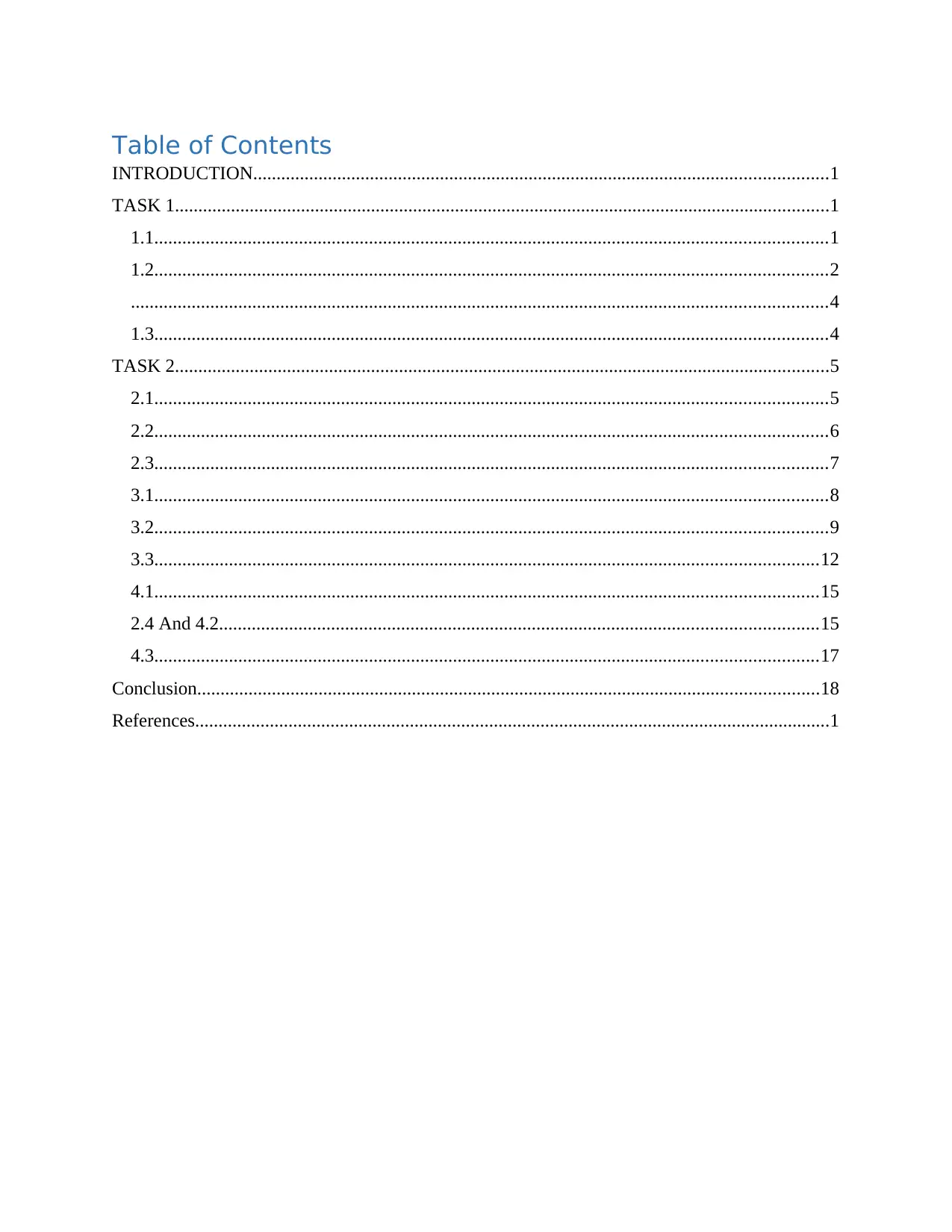
Table of Contents
INTRODUCTION...........................................................................................................................1
TASK 1............................................................................................................................................1
1.1................................................................................................................................................1
1.2................................................................................................................................................2
.....................................................................................................................................................4
1.3................................................................................................................................................4
TASK 2............................................................................................................................................5
2.1................................................................................................................................................5
2.2................................................................................................................................................6
2.3................................................................................................................................................7
3.1................................................................................................................................................8
3.2................................................................................................................................................9
3.3..............................................................................................................................................12
4.1..............................................................................................................................................15
2.4 And 4.2................................................................................................................................15
4.3..............................................................................................................................................17
Conclusion.....................................................................................................................................18
References........................................................................................................................................1
INTRODUCTION...........................................................................................................................1
TASK 1............................................................................................................................................1
1.1................................................................................................................................................1
1.2................................................................................................................................................2
.....................................................................................................................................................4
1.3................................................................................................................................................4
TASK 2............................................................................................................................................5
2.1................................................................................................................................................5
2.2................................................................................................................................................6
2.3................................................................................................................................................7
3.1................................................................................................................................................8
3.2................................................................................................................................................9
3.3..............................................................................................................................................12
4.1..............................................................................................................................................15
2.4 And 4.2................................................................................................................................15
4.3..............................................................................................................................................17
Conclusion.....................................................................................................................................18
References........................................................................................................................................1
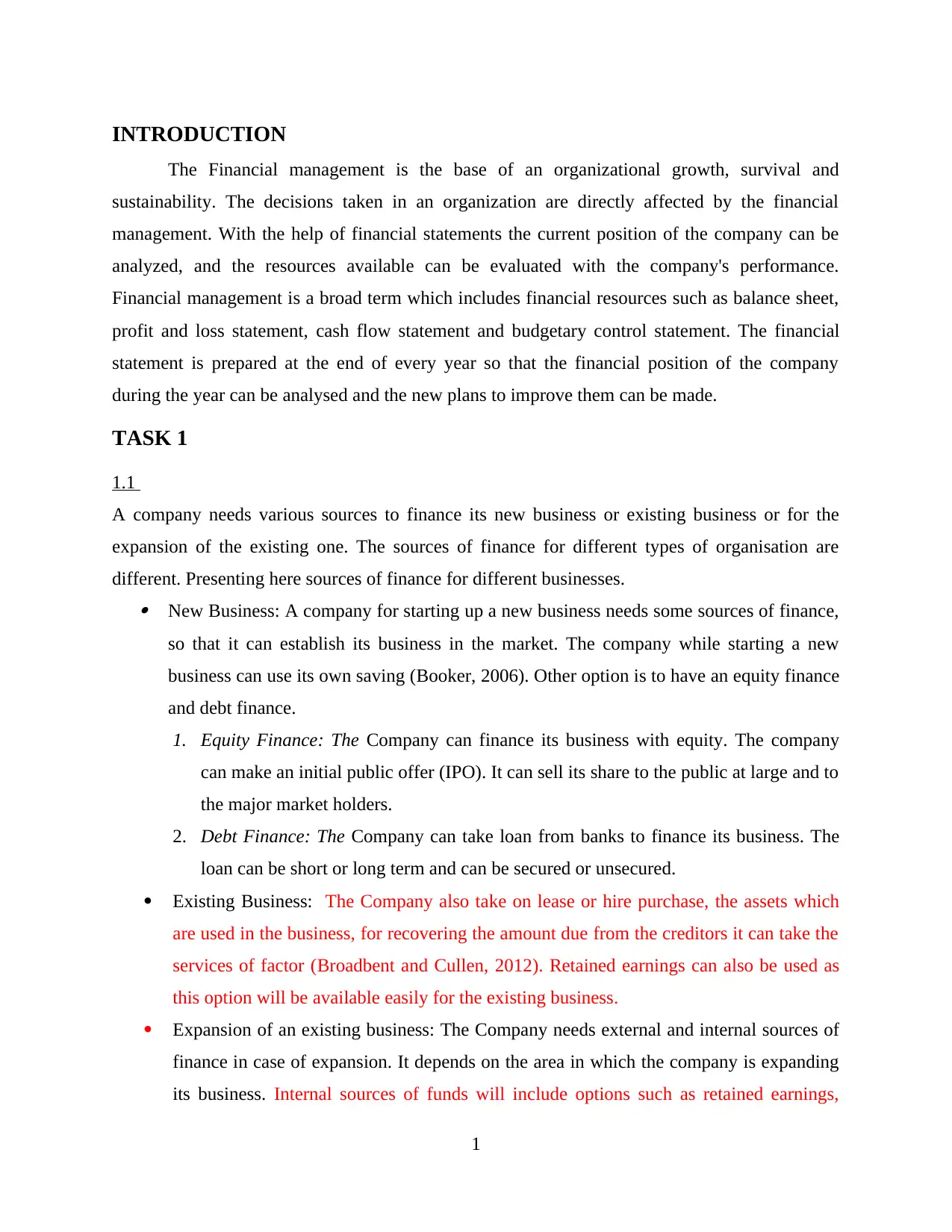
INTRODUCTION
The Financial management is the base of an organizational growth, survival and
sustainability. The decisions taken in an organization are directly affected by the financial
management. With the help of financial statements the current position of the company can be
analyzed, and the resources available can be evaluated with the company's performance.
Financial management is a broad term which includes financial resources such as balance sheet,
profit and loss statement, cash flow statement and budgetary control statement. The financial
statement is prepared at the end of every year so that the financial position of the company
during the year can be analysed and the new plans to improve them can be made.
TASK 1
1.1
A company needs various sources to finance its new business or existing business or for the
expansion of the existing one. The sources of finance for different types of organisation are
different. Presenting here sources of finance for different businesses. New Business: A company for starting up a new business needs some sources of finance,
so that it can establish its business in the market. The company while starting a new
business can use its own saving (Booker, 2006). Other option is to have an equity finance
and debt finance.
1. Equity Finance: The Company can finance its business with equity. The company
can make an initial public offer (IPO). It can sell its share to the public at large and to
the major market holders.
2. Debt Finance: The Company can take loan from banks to finance its business. The
loan can be short or long term and can be secured or unsecured.
Existing Business: The Company also take on lease or hire purchase, the assets which
are used in the business, for recovering the amount due from the creditors it can take the
services of factor (Broadbent and Cullen, 2012). Retained earnings can also be used as
this option will be available easily for the existing business.
Expansion of an existing business: The Company needs external and internal sources of
finance in case of expansion. It depends on the area in which the company is expanding
its business. Internal sources of funds will include options such as retained earnings,
1
The Financial management is the base of an organizational growth, survival and
sustainability. The decisions taken in an organization are directly affected by the financial
management. With the help of financial statements the current position of the company can be
analyzed, and the resources available can be evaluated with the company's performance.
Financial management is a broad term which includes financial resources such as balance sheet,
profit and loss statement, cash flow statement and budgetary control statement. The financial
statement is prepared at the end of every year so that the financial position of the company
during the year can be analysed and the new plans to improve them can be made.
TASK 1
1.1
A company needs various sources to finance its new business or existing business or for the
expansion of the existing one. The sources of finance for different types of organisation are
different. Presenting here sources of finance for different businesses. New Business: A company for starting up a new business needs some sources of finance,
so that it can establish its business in the market. The company while starting a new
business can use its own saving (Booker, 2006). Other option is to have an equity finance
and debt finance.
1. Equity Finance: The Company can finance its business with equity. The company
can make an initial public offer (IPO). It can sell its share to the public at large and to
the major market holders.
2. Debt Finance: The Company can take loan from banks to finance its business. The
loan can be short or long term and can be secured or unsecured.
Existing Business: The Company also take on lease or hire purchase, the assets which
are used in the business, for recovering the amount due from the creditors it can take the
services of factor (Broadbent and Cullen, 2012). Retained earnings can also be used as
this option will be available easily for the existing business.
Expansion of an existing business: The Company needs external and internal sources of
finance in case of expansion. It depends on the area in which the company is expanding
its business. Internal sources of funds will include options such as retained earnings,
1
⊘ This is a preview!⊘
Do you want full access?
Subscribe today to unlock all pages.

Trusted by 1+ million students worldwide
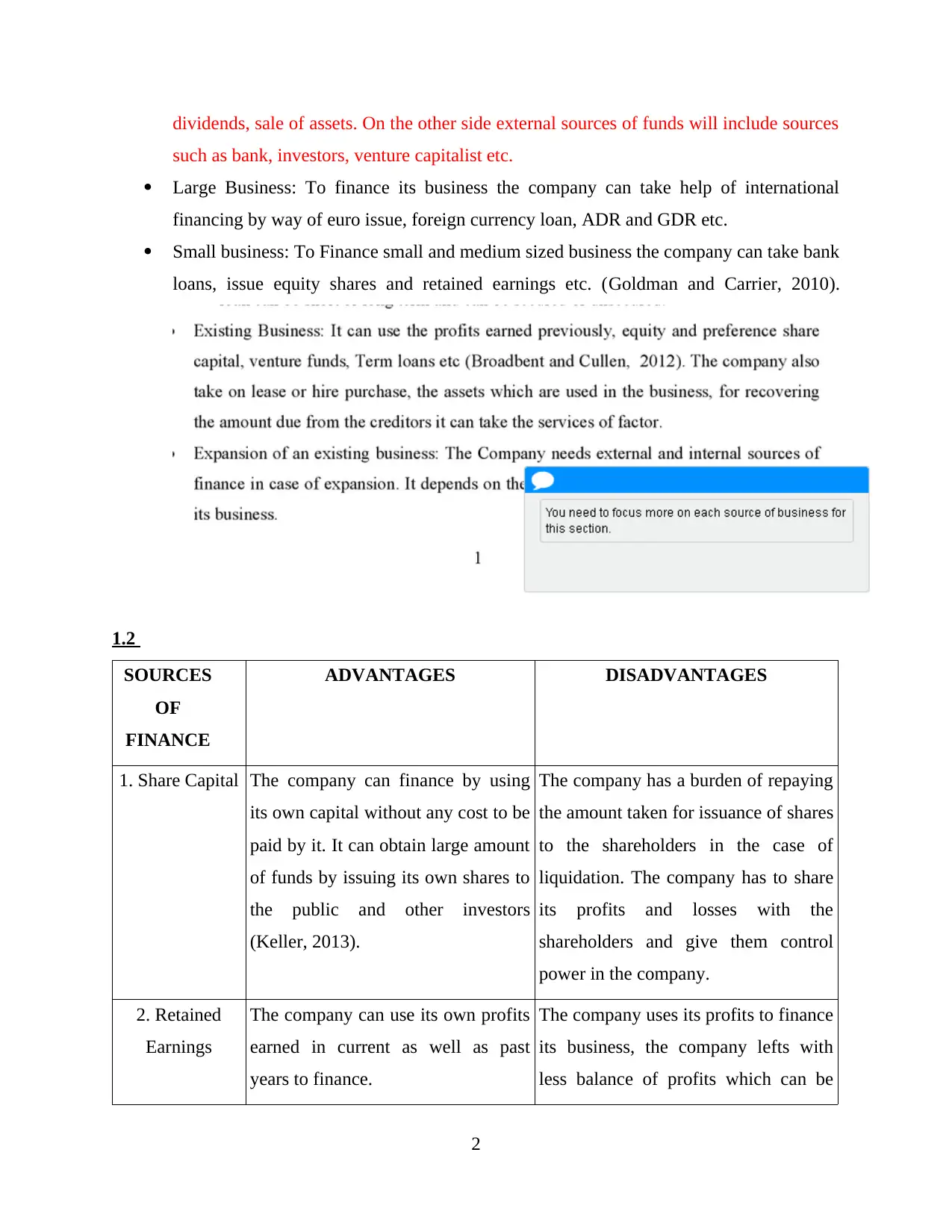
dividends, sale of assets. On the other side external sources of funds will include sources
such as bank, investors, venture capitalist etc.
Large Business: To finance its business the company can take help of international
financing by way of euro issue, foreign currency loan, ADR and GDR etc.
Small business: To Finance small and medium sized business the company can take bank
loans, issue equity shares and retained earnings etc. (Goldman and Carrier, 2010).
1.2
SOURCES
OF
FINANCE
ADVANTAGES DISADVANTAGES
1. Share Capital The company can finance by using
its own capital without any cost to be
paid by it. It can obtain large amount
of funds by issuing its own shares to
the public and other investors
(Keller, 2013).
The company has a burden of repaying
the amount taken for issuance of shares
to the shareholders in the case of
liquidation. The company has to share
its profits and losses with the
shareholders and give them control
power in the company.
2. Retained
Earnings
The company can use its own profits
earned in current as well as past
years to finance.
The company uses its profits to finance
its business, the company lefts with
less balance of profits which can be
2
such as bank, investors, venture capitalist etc.
Large Business: To finance its business the company can take help of international
financing by way of euro issue, foreign currency loan, ADR and GDR etc.
Small business: To Finance small and medium sized business the company can take bank
loans, issue equity shares and retained earnings etc. (Goldman and Carrier, 2010).
1.2
SOURCES
OF
FINANCE
ADVANTAGES DISADVANTAGES
1. Share Capital The company can finance by using
its own capital without any cost to be
paid by it. It can obtain large amount
of funds by issuing its own shares to
the public and other investors
(Keller, 2013).
The company has a burden of repaying
the amount taken for issuance of shares
to the shareholders in the case of
liquidation. The company has to share
its profits and losses with the
shareholders and give them control
power in the company.
2. Retained
Earnings
The company can use its own profits
earned in current as well as past
years to finance.
The company uses its profits to finance
its business, the company lefts with
less balance of profits which can be
2
Paraphrase This Document
Need a fresh take? Get an instant paraphrase of this document with our AI Paraphraser
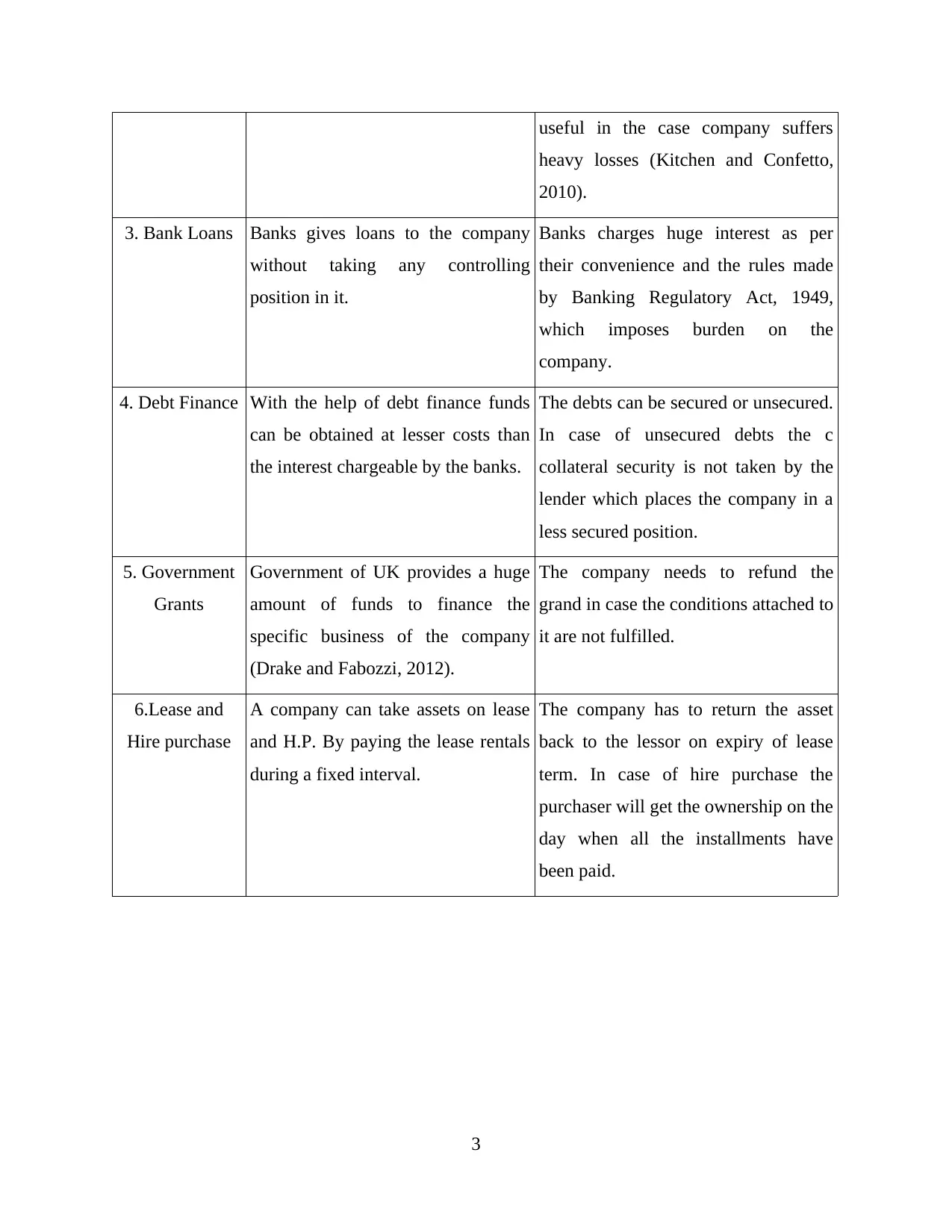
useful in the case company suffers
heavy losses (Kitchen and Confetto,
2010).
3. Bank Loans Banks gives loans to the company
without taking any controlling
position in it.
Banks charges huge interest as per
their convenience and the rules made
by Banking Regulatory Act, 1949,
which imposes burden on the
company.
4. Debt Finance With the help of debt finance funds
can be obtained at lesser costs than
the interest chargeable by the banks.
The debts can be secured or unsecured.
In case of unsecured debts the c
collateral security is not taken by the
lender which places the company in a
less secured position.
5. Government
Grants
Government of UK provides a huge
amount of funds to finance the
specific business of the company
(Drake and Fabozzi, 2012).
The company needs to refund the
grand in case the conditions attached to
it are not fulfilled.
6.Lease and
Hire purchase
A company can take assets on lease
and H.P. By paying the lease rentals
during a fixed interval.
The company has to return the asset
back to the lessor on expiry of lease
term. In case of hire purchase the
purchaser will get the ownership on the
day when all the installments have
been paid.
3
heavy losses (Kitchen and Confetto,
2010).
3. Bank Loans Banks gives loans to the company
without taking any controlling
position in it.
Banks charges huge interest as per
their convenience and the rules made
by Banking Regulatory Act, 1949,
which imposes burden on the
company.
4. Debt Finance With the help of debt finance funds
can be obtained at lesser costs than
the interest chargeable by the banks.
The debts can be secured or unsecured.
In case of unsecured debts the c
collateral security is not taken by the
lender which places the company in a
less secured position.
5. Government
Grants
Government of UK provides a huge
amount of funds to finance the
specific business of the company
(Drake and Fabozzi, 2012).
The company needs to refund the
grand in case the conditions attached to
it are not fulfilled.
6.Lease and
Hire purchase
A company can take assets on lease
and H.P. By paying the lease rentals
during a fixed interval.
The company has to return the asset
back to the lessor on expiry of lease
term. In case of hire purchase the
purchaser will get the ownership on the
day when all the installments have
been paid.
3
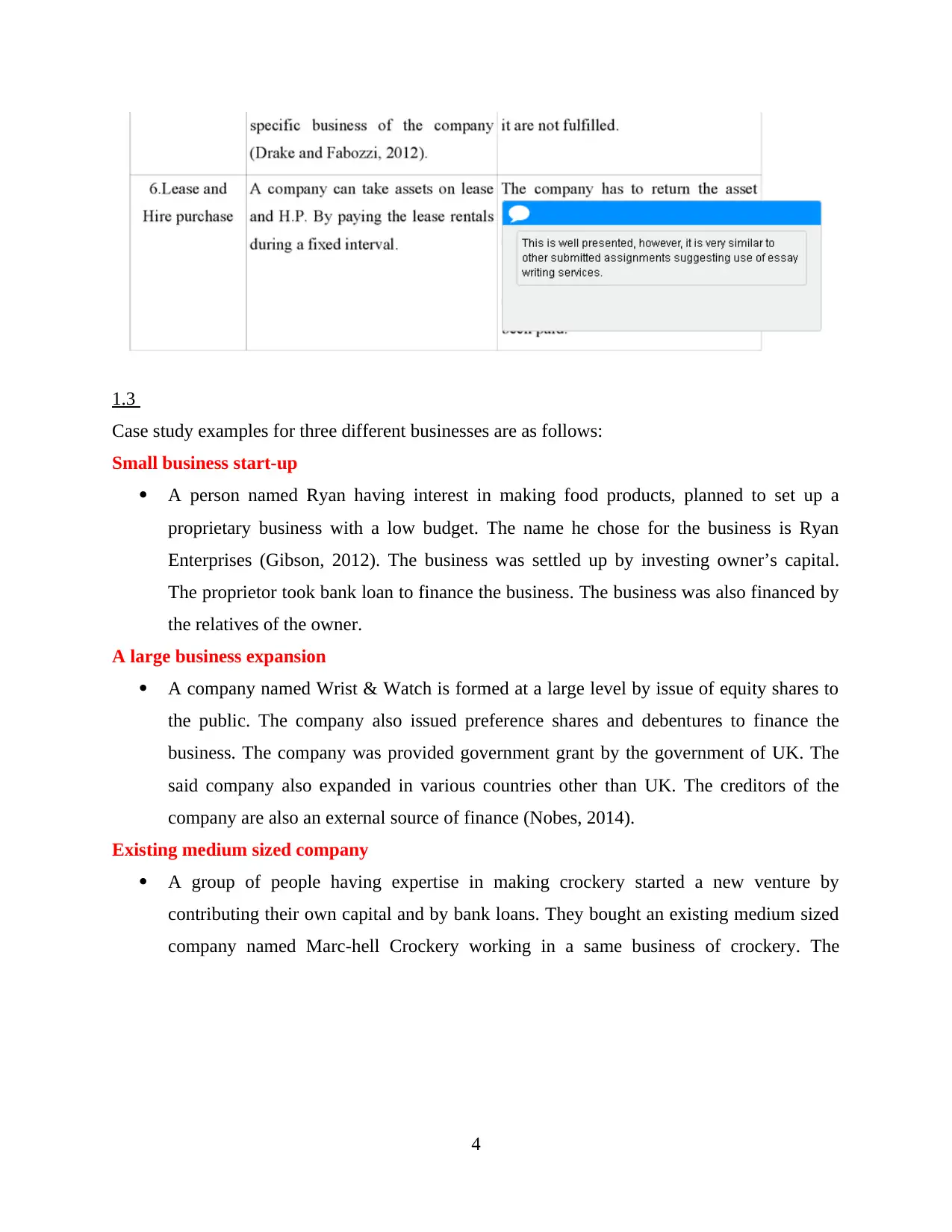
1.3
Case study examples for three different businesses are as follows:
Small business start-up
A person named Ryan having interest in making food products, planned to set up a
proprietary business with a low budget. The name he chose for the business is Ryan
Enterprises (Gibson, 2012). The business was settled up by investing owner’s capital.
The proprietor took bank loan to finance the business. The business was also financed by
the relatives of the owner.
A large business expansion
A company named Wrist & Watch is formed at a large level by issue of equity shares to
the public. The company also issued preference shares and debentures to finance the
business. The company was provided government grant by the government of UK. The
said company also expanded in various countries other than UK. The creditors of the
company are also an external source of finance (Nobes, 2014).
Existing medium sized company
A group of people having expertise in making crockery started a new venture by
contributing their own capital and by bank loans. They bought an existing medium sized
company named Marc-hell Crockery working in a same business of crockery. The
4
Case study examples for three different businesses are as follows:
Small business start-up
A person named Ryan having interest in making food products, planned to set up a
proprietary business with a low budget. The name he chose for the business is Ryan
Enterprises (Gibson, 2012). The business was settled up by investing owner’s capital.
The proprietor took bank loan to finance the business. The business was also financed by
the relatives of the owner.
A large business expansion
A company named Wrist & Watch is formed at a large level by issue of equity shares to
the public. The company also issued preference shares and debentures to finance the
business. The company was provided government grant by the government of UK. The
said company also expanded in various countries other than UK. The creditors of the
company are also an external source of finance (Nobes, 2014).
Existing medium sized company
A group of people having expertise in making crockery started a new venture by
contributing their own capital and by bank loans. They bought an existing medium sized
company named Marc-hell Crockery working in a same business of crockery. The
4
⊘ This is a preview!⊘
Do you want full access?
Subscribe today to unlock all pages.

Trusted by 1+ million students worldwide
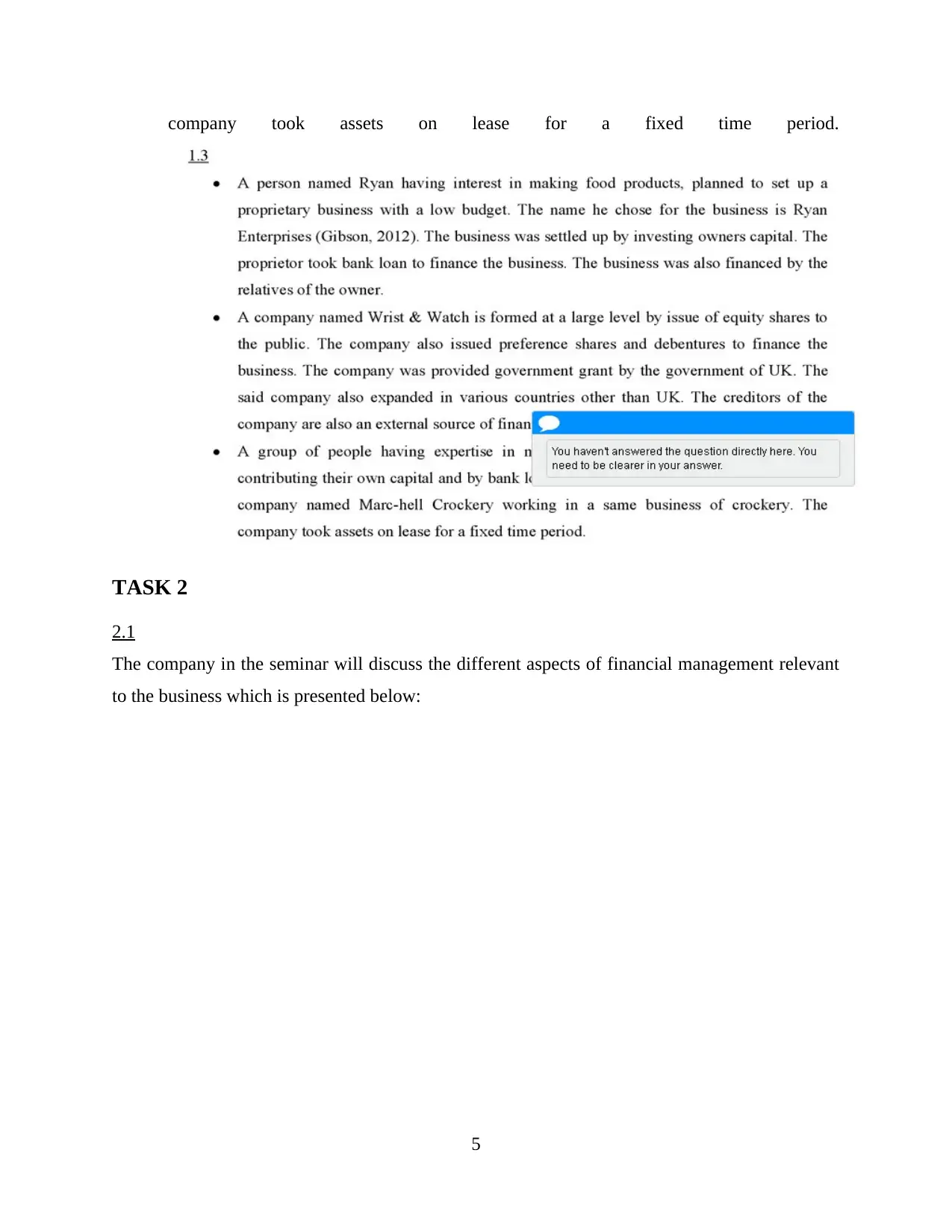
company took assets on lease for a fixed time period.
TASK 2
2.1
The company in the seminar will discuss the different aspects of financial management relevant
to the business which is presented below:
5
TASK 2
2.1
The company in the seminar will discuss the different aspects of financial management relevant
to the business which is presented below:
5
Paraphrase This Document
Need a fresh take? Get an instant paraphrase of this document with our AI Paraphraser
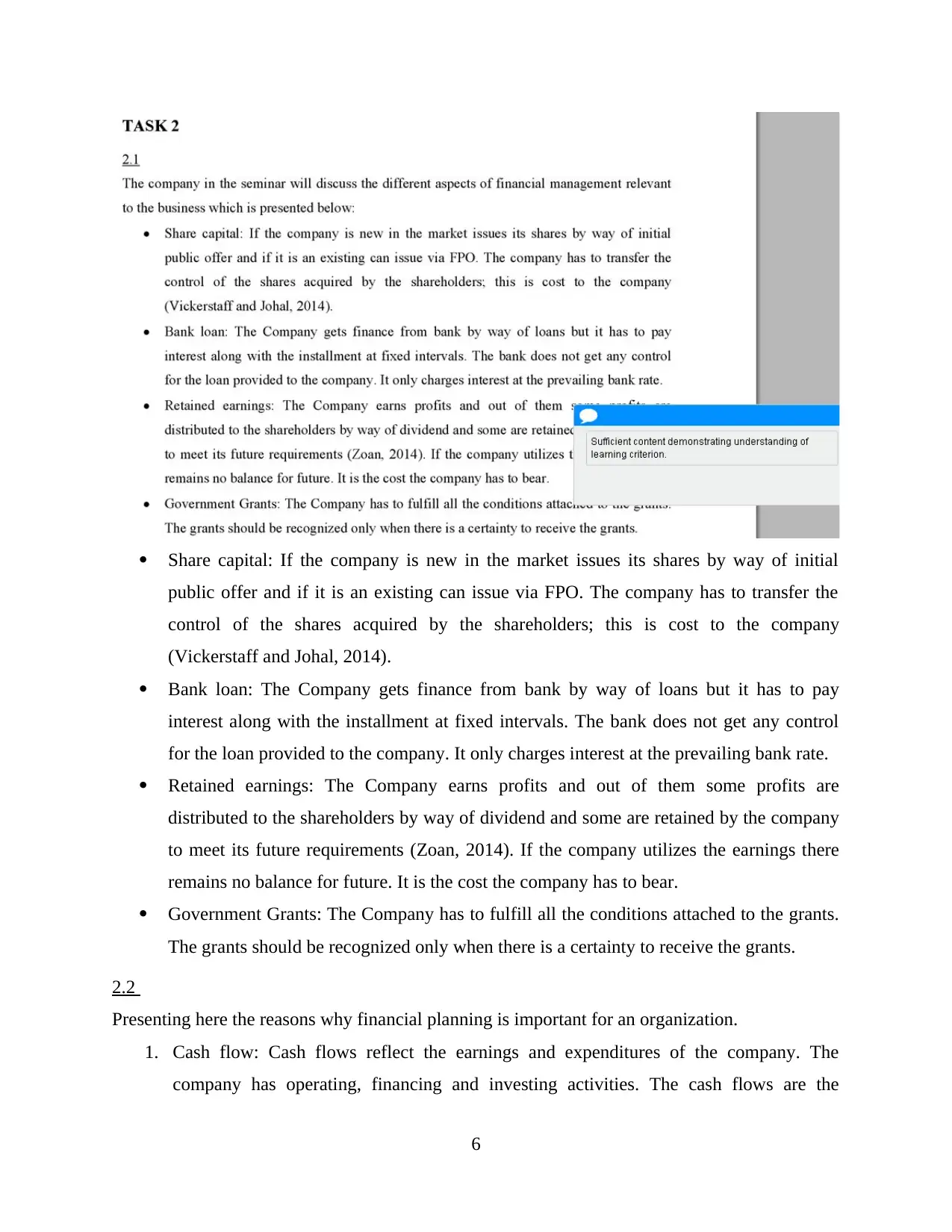
Share capital: If the company is new in the market issues its shares by way of initial
public offer and if it is an existing can issue via FPO. The company has to transfer the
control of the shares acquired by the shareholders; this is cost to the company
(Vickerstaff and Johal, 2014).
Bank loan: The Company gets finance from bank by way of loans but it has to pay
interest along with the installment at fixed intervals. The bank does not get any control
for the loan provided to the company. It only charges interest at the prevailing bank rate.
Retained earnings: The Company earns profits and out of them some profits are
distributed to the shareholders by way of dividend and some are retained by the company
to meet its future requirements (Zoan, 2014). If the company utilizes the earnings there
remains no balance for future. It is the cost the company has to bear.
Government Grants: The Company has to fulfill all the conditions attached to the grants.
The grants should be recognized only when there is a certainty to receive the grants.
2.2
Presenting here the reasons why financial planning is important for an organization.
1. Cash flow: Cash flows reflect the earnings and expenditures of the company. The
company has operating, financing and investing activities. The cash flows are the
6
public offer and if it is an existing can issue via FPO. The company has to transfer the
control of the shares acquired by the shareholders; this is cost to the company
(Vickerstaff and Johal, 2014).
Bank loan: The Company gets finance from bank by way of loans but it has to pay
interest along with the installment at fixed intervals. The bank does not get any control
for the loan provided to the company. It only charges interest at the prevailing bank rate.
Retained earnings: The Company earns profits and out of them some profits are
distributed to the shareholders by way of dividend and some are retained by the company
to meet its future requirements (Zoan, 2014). If the company utilizes the earnings there
remains no balance for future. It is the cost the company has to bear.
Government Grants: The Company has to fulfill all the conditions attached to the grants.
The grants should be recognized only when there is a certainty to receive the grants.
2.2
Presenting here the reasons why financial planning is important for an organization.
1. Cash flow: Cash flows reflect the earnings and expenditures of the company. The
company has operating, financing and investing activities. The cash flows are the
6
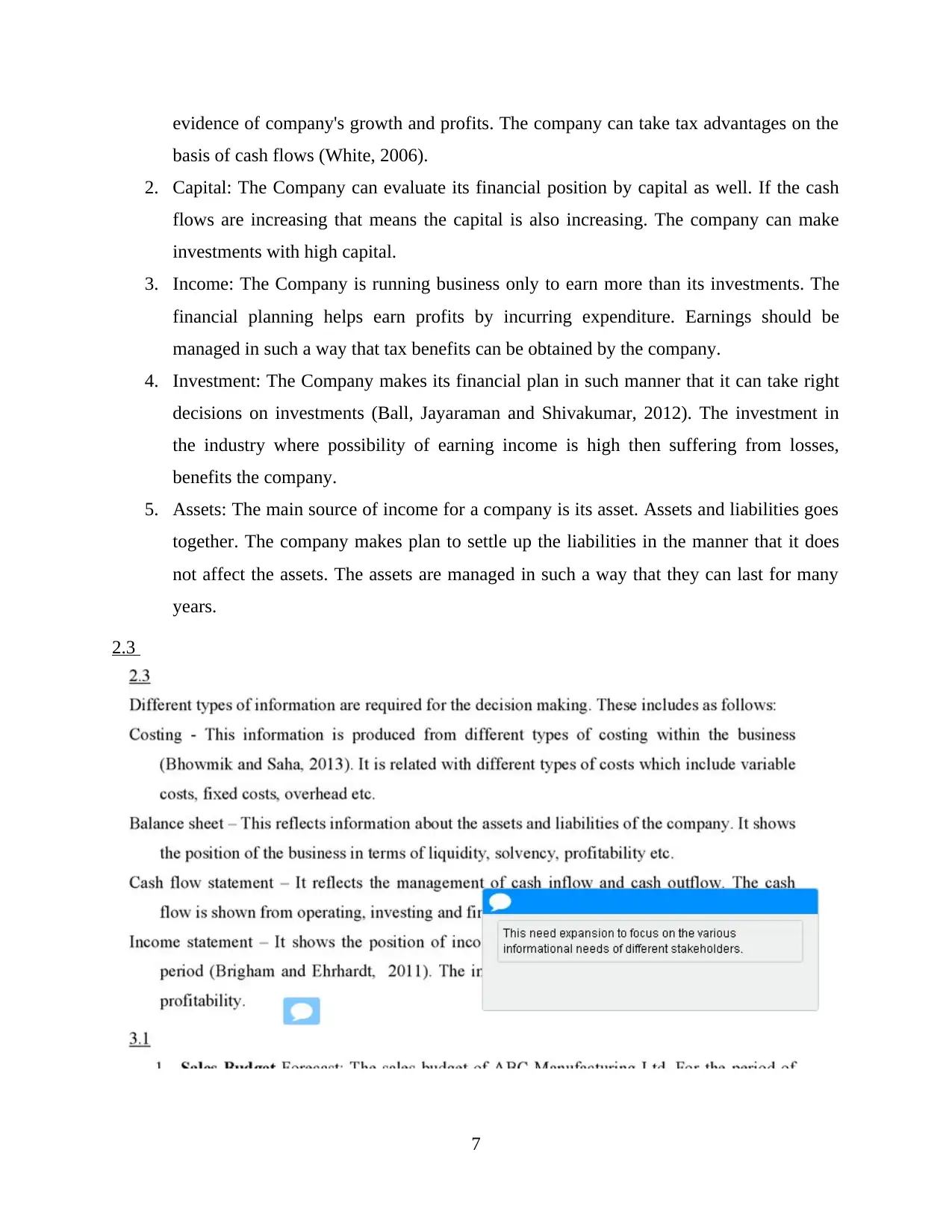
evidence of company's growth and profits. The company can take tax advantages on the
basis of cash flows (White, 2006).
2. Capital: The Company can evaluate its financial position by capital as well. If the cash
flows are increasing that means the capital is also increasing. The company can make
investments with high capital.
3. Income: The Company is running business only to earn more than its investments. The
financial planning helps earn profits by incurring expenditure. Earnings should be
managed in such a way that tax benefits can be obtained by the company.
4. Investment: The Company makes its financial plan in such manner that it can take right
decisions on investments (Ball, Jayaraman and Shivakumar, 2012). The investment in
the industry where possibility of earning income is high then suffering from losses,
benefits the company.
5. Assets: The main source of income for a company is its asset. Assets and liabilities goes
together. The company makes plan to settle up the liabilities in the manner that it does
not affect the assets. The assets are managed in such a way that they can last for many
years.
2.3
7
basis of cash flows (White, 2006).
2. Capital: The Company can evaluate its financial position by capital as well. If the cash
flows are increasing that means the capital is also increasing. The company can make
investments with high capital.
3. Income: The Company is running business only to earn more than its investments. The
financial planning helps earn profits by incurring expenditure. Earnings should be
managed in such a way that tax benefits can be obtained by the company.
4. Investment: The Company makes its financial plan in such manner that it can take right
decisions on investments (Ball, Jayaraman and Shivakumar, 2012). The investment in
the industry where possibility of earning income is high then suffering from losses,
benefits the company.
5. Assets: The main source of income for a company is its asset. Assets and liabilities goes
together. The company makes plan to settle up the liabilities in the manner that it does
not affect the assets. The assets are managed in such a way that they can last for many
years.
2.3
7
⊘ This is a preview!⊘
Do you want full access?
Subscribe today to unlock all pages.

Trusted by 1+ million students worldwide
1 out of 24
Related Documents
Your All-in-One AI-Powered Toolkit for Academic Success.
+13062052269
info@desklib.com
Available 24*7 on WhatsApp / Email
![[object Object]](/_next/static/media/star-bottom.7253800d.svg)
Unlock your academic potential
Copyright © 2020–2025 A2Z Services. All Rights Reserved. Developed and managed by ZUCOL.





